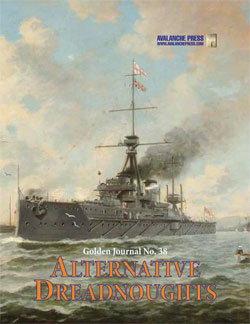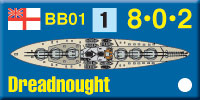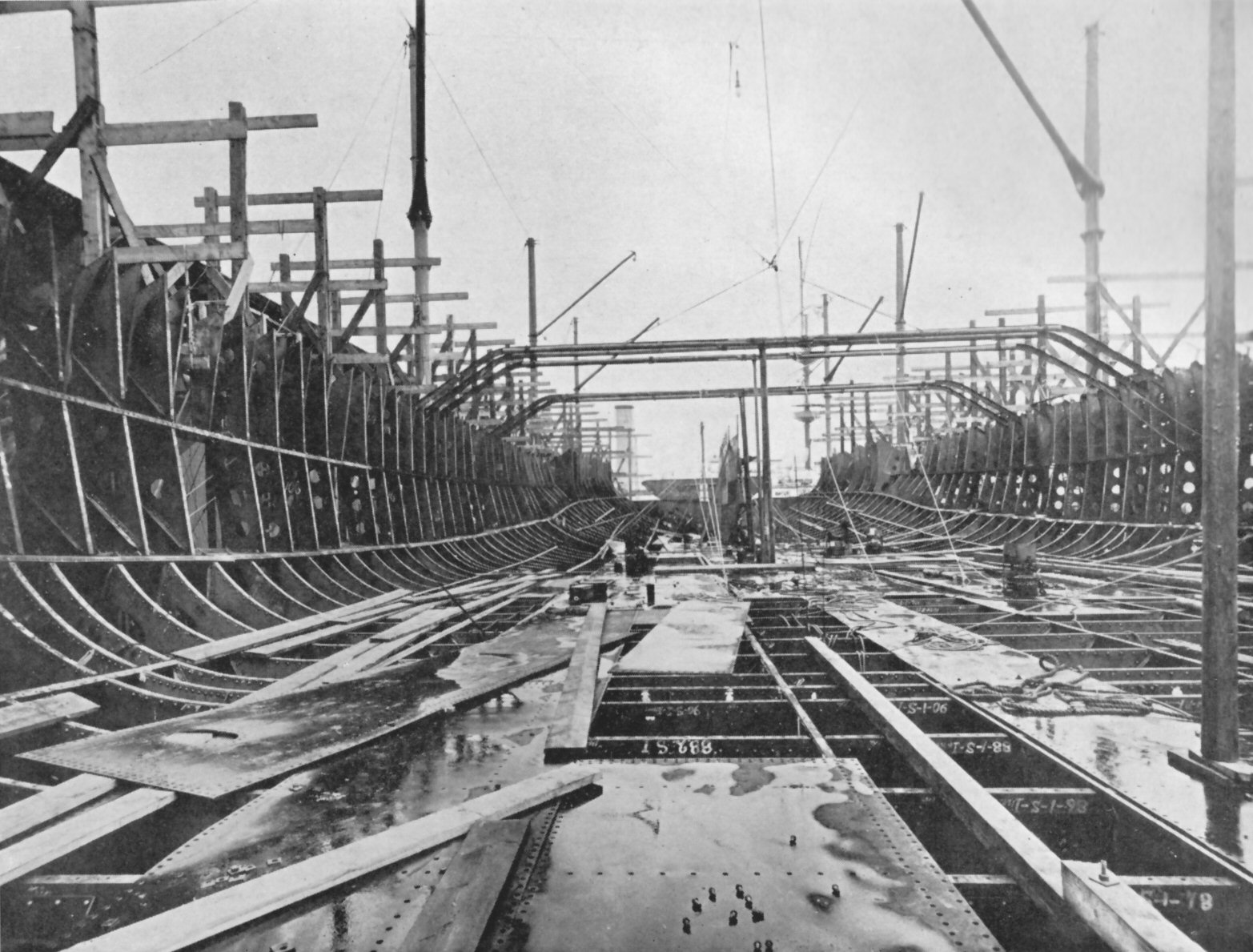| Jutland:
Alternative
Dreadnoughts, Part Three
By Mike Bennighof, Ph.D.
April 2021
 Once First Sea Lord Sir John Fisher had committed to a completely new battleship design to follow the Lord Nelson class, the Director of Naval Construction, Sir Philip Watts, and his deputy, J.H. Narbeth, could present the new ideas they’d worked up for such a ship. Once First Sea Lord Sir John Fisher had committed to a completely new battleship design to follow the Lord Nelson class, the Director of Naval Construction, Sir Philip Watts, and his deputy, J.H. Narbeth, could present the new ideas they’d worked up for such a ship.
Only seven docks within the British Empire could accommodate a ship of the proposed size, though a dozen more were under construction. Fisher didn’t care; the new ship would have such greater combat power than existing battleships that the investment in new or enlarged facilities would be worthwhile (and would not come out of the budget for new construction).
Despite the commitment to an enlarged battleship, both Watts and Narbeth worked to reduce the weight of their proposed ships. In place of the proven reciprocal engines used by all previous British battleships, the new battleship would be driven by turbines, only recently introduced and still considered an unproven technology.
That would give Fisher what he wanted: a ship using the newest technology, armed only with big guns and some light weapons to fend off enemy torpedo boats, and a fleet speed of 21 knots. In January 1905 Fisher convened a special Committee on Designs made up of both naval and civilian experts to make recommendations for five different new types of ship, ranging from destroyers through battleships. All of these designs would take radically new approaches; the new armored cruiser would share the all-big-gun philosophy of the new battleship with a main battery of 12-inch guns and a turbine-driven top speed of 21 knots.

The flush-deck arrangement finally chosen for Dreadnought’s aft turrets.
A former First Sea Lord, the retired Admiral Sir Arthur K. Wilson, pointed out to Fisher that both fleet and tabletop exercises showed that combat between opposing battle fleets always came down to an exchange of broadsides. The new ship design, Wilson argued, should maximize its weight of broadside fire with all turrets mounted on the ship’s center line.
On Fisher’s instructions, Narbeth sketched a ship to match Wilson’s vision. This ship, which Fisher labelled HMS Untakeable, would be much larger than nay warship yet built at 20,700 tons’ displacement and 555 feet in length. Her power plant would generate the unheard-of total of 27,000 horsepower to make the required 21 knots.
 For her size, she would deliver unprecedented firepower: a dozen 12-inch guns, arrayed in a pair of what Narbeth called “castles” forward and aft. Each castle consisted of three super-firing twin turrets stacked one above and behind the next, giving the ship six guns firing fore and aft and the full dozen on the broadside. Fisher liked the ship, but his Committee did not – unproven propulsion technology was one thing, but little study had been done regarding the blast effects of the super-firing arrangement. Some feared that the crews of the lower turrets might be rendered unconscious or even killed when heavy guns were fired directly above their heads. The added weight of the tallest of the three armored barbettes underpinning each castle also proved a point of concern. For her size, she would deliver unprecedented firepower: a dozen 12-inch guns, arrayed in a pair of what Narbeth called “castles” forward and aft. Each castle consisted of three super-firing twin turrets stacked one above and behind the next, giving the ship six guns firing fore and aft and the full dozen on the broadside. Fisher liked the ship, but his Committee did not – unproven propulsion technology was one thing, but little study had been done regarding the blast effects of the super-firing arrangement. Some feared that the crews of the lower turrets might be rendered unconscious or even killed when heavy guns were fired directly above their heads. The added weight of the tallest of the three armored barbettes underpinning each castle also proved a point of concern.
A variation on the castle ship removed the topmost forward turret and cur down the quarterdeck by one level, reducing the ship’s weight to 19,000 tons, her length to 530 feet and her estimated price tag from £1.94 million to £1.7 million. She kept her speed of 21 knots, but of course saw her broadside reduced from a dozen to just ten guns.
 As a cheaper alternative, Narbeth also drafted a version with just one turret forward and the full “castle” of three turrets after, for a total of eight guns. She would be much smaller than the other ships and less costly, and perhaps most importantly would not require a complete reconstruction of the Empire’s docking facilities. As a cheaper alternative, Narbeth also drafted a version with just one turret forward and the full “castle” of three turrets after, for a total of eight guns. She would be much smaller than the other ships and less costly, and perhaps most importantly would not require a complete reconstruction of the Empire’s docking facilities.
But none of these ships satisfied the Committee, which cited experiments that recommended a separation of at least 63 feet between 12-inch gun turrets, measured from center to center, with 70 feet a preferred distance. The Committee also balked at the use of turbines, but a special presentation by Charles Parsons, who had developed the new technology, allayed their fears and they consented to their use in the new ship.
That still left the ship’s layout to be decided, and Fisher would not accept the “hexagonal” ship sketched by Narbeth on the basis of Lord Nelson. This ship carried a dozen 12-inch guns, but only eight could fire on either broadside. Watts sketched a compromise designed, replacing the after pair of wing turrets on Narbeth’s ship with a single turret sited on the ship’s centerline; he had hoped to do the same with the forward wing turrets but could not make the arrangement work because of the engine spaces below decks.
This design, now labelled Dreadnought by Fisher, received the Committee’s stamp of approval in March 1905 and she was included in the Naval Estimates (the proposed budget presented to Parliament) as an experimental ship. Rapidly approved, her contract was awarded to the Portsmouth Naval Dockyard, which had already begun to collect material for the new ship.

Preparation matters. Dreadnought two days after her keel had been laid.
Fisher demanded that she be completed as quickly as possible; knowing her to be revolutionary, he did not wish foreign rivals to get a head start on building similar ships of their own. Dreadnought was laid down in October 1905, launched in February 1906 and commissioned in December of the same year, an astonishing speed of construction. In addition to use of stockpiled materials, the dockyard also sped the project by stripping the main armament from the two Lord Nelson-class pre-dreadnoughts then under construction at private shipyards. Those ships would be delivered more than a year late, and already obsolete when they hoisted the White Ensign. No thought seems to have been given to scrapping them, as they had already been launched in May 1905, or selling them to a foreign owner.
Dreadnought had been designed and built far too quickly and displayed a number of flaws; she spent most of the Great War operating with the pre-dreadnoughts of the King Edward VII class and was considered worn out before the war was over, just a dozen years after completion.
Click here to order Jutland right now.
Sign up for our newsletter right here. Your info will never be sold or transferred; we'll just use it to update you on new games and new offers.
Mike Bennighof is president of Avalanche Press and holds a doctorate in history from Emory University. A Fulbright Scholar and NASA Journalist in Space finalist, he has published countless books, games and articles on historical subjects.
He lives in Birmingham, Alabama with his wife, three children and his dog, Leopold.
Want to keep Daily Content free of third-party ads? You can send us some love (and cash) through this link right here. You don’t have to, but Leopold would like it if you did.
|
